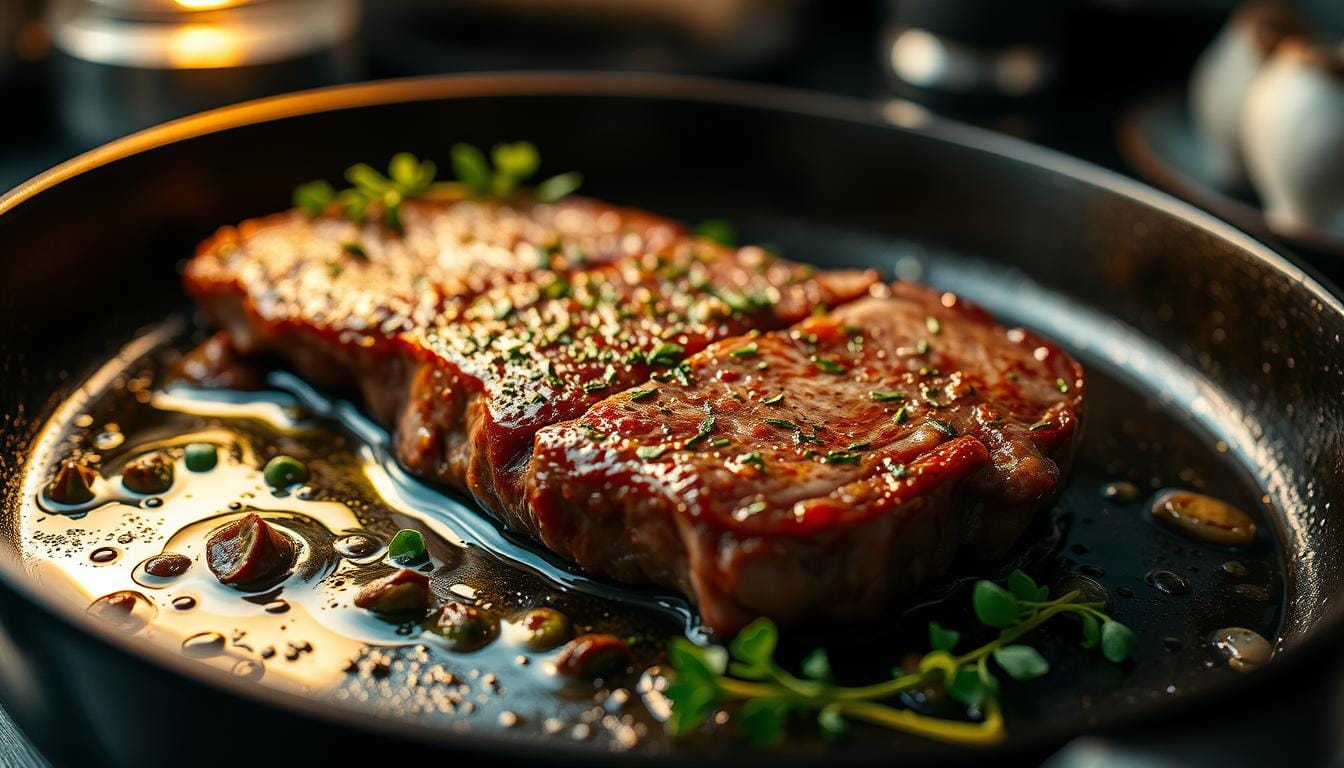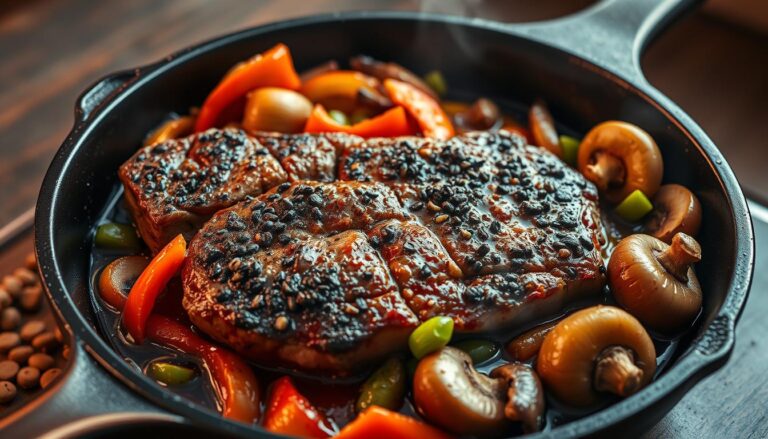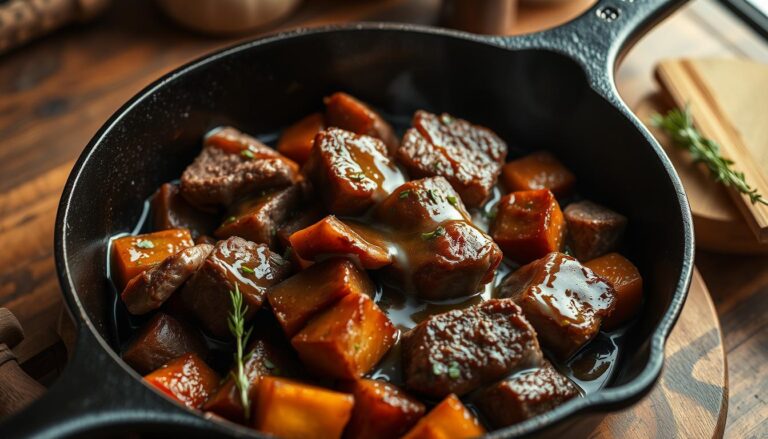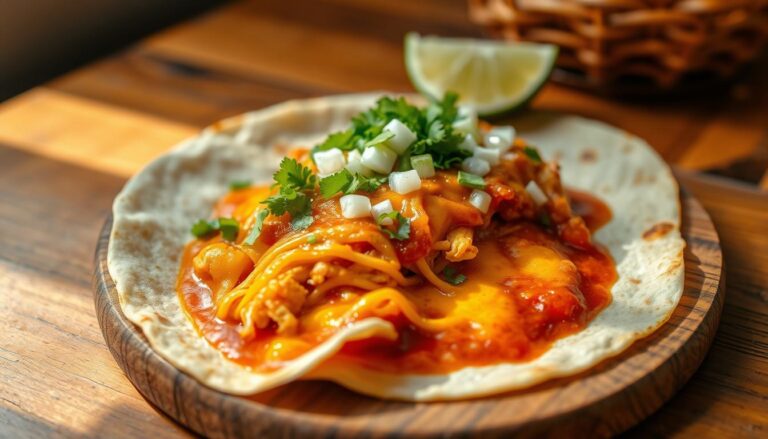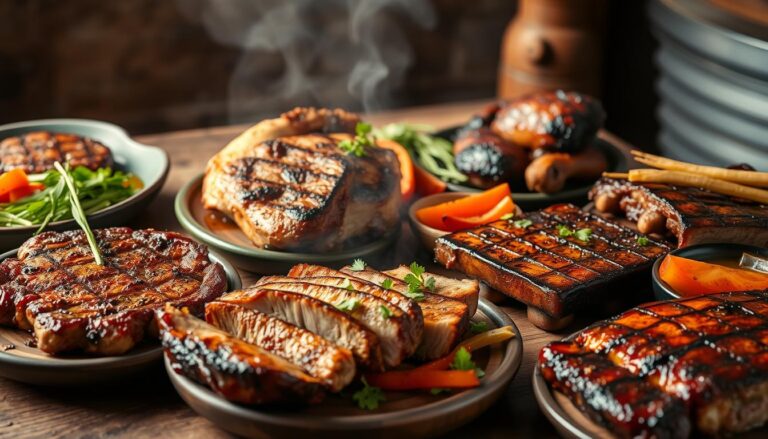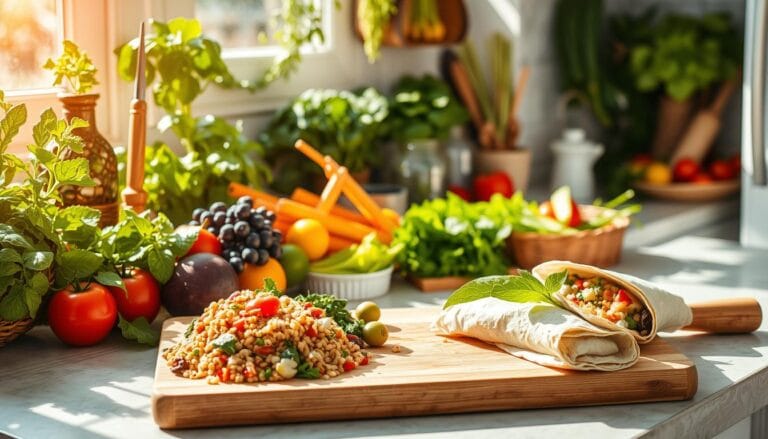Denver Steak Recipe: Juicy, Flavorful, and Simple to Prepare
Every home cook dreams of mastering the perfect beef cuts. The Denver steak might just be your secret weapon in the kitchen. I remember the first time I discovered this hidden gem at my local butcher shop. It was so tender and flavorful, it changed my weekend cooking experience.
The Denver steak is a remarkable cut from the chuck section. It offers an incredible balance of tenderness and rich flavor. This steak provides restaurant-quality taste without breaking the bank.
Whether you’re a seasoned chef or a cooking enthusiast, this Denver steak recipe will guide you. It will help you create a mouthwatering meal that will impress your family and friends. Get ready to unlock the secrets of preparing a perfectly juicy and delicious steak right in your own kitchen.
Table of Contents
What is Denver Steak and Why It’s Special
The Denver steak is a hidden gem among beef cuts that deserves your attention. It combines the best qualities of premium beef cuts, offering an exceptional eating experience. Unlike traditional beef cuts, the Denver steak stands out for its remarkable tenderness and rich flavor profile.
Denver steak comes from an unexpected location within the beef cuts. It originates from the chuck section of the cow, specifically the shoulder area. This placement might surprise many beef lovers who typically associate premium steaks with other parts of the animal.
Understanding the Cut Location
The Denver steak is located beneath the shoulder blade, in the chuck roll. Its unique position contributes to several distinctive characteristics:
- Less worked muscle group compared to other chuck regions
- Protected area with minimal muscle movement
- Naturally tender due to its specific anatomical location
Marbling and Tenderness Profile
What makes the Denver steak truly exceptional is its impressive marbling. The inter-muscular fat is beautifully distributed, creating a tender and flavorful eating experience. This rivals more expensive beef cuts like beef tenderloin.
Cost-Effectiveness Compared to Other Cuts
Budget-conscious meat lovers will appreciate the Denver steak’s exceptional value. This cut offers restaurant-quality taste and texture at a fraction of the price of premium beef cuts. You can enjoy a luxurious steak experience without breaking the bank.
The Denver steak proves that exceptional flavor isn’t always about the most expensive cut, but about understanding the unique qualities of each beef cut.
Essential Ingredients for Perfect Denver Steak
Making a delicious Denver steak starts with the right ingredients. Your denver steak seasoning can turn a simple cut into a gourmet meal. It’s all about picking ingredients that boost the meat’s flavor without overpowering it.
- Kosher salt
- Freshly ground black pepper
- Garlic powder
- Dried herbs like thyme or rosemary
If you’re into marinades, you’ll need ingredients that make the meat tender and taste better. A classic marinade usually has:
| Ingredient | Purpose |
|---|---|
| Olive oil | Helps distribute seasonings |
| Balsamic vinegar | Adds depth and helps tenderize |
| Worcestershire sauce | Provides umami flavor |
“The secret to a great steak is simplicity and quality ingredients” – Professional Chef
Marinades can be tailored to your taste. Try out different mixes to find your favorite flavor. The aim is to add to the steak’s natural taste, not hide it.
Preparing Your Denver Steak for Cooking
Turning a good Denver steak into a great meal starts with the right prep. Knowing how to get your steak ready for cooking is key. It can really change your dish for the better.
Room Temperature Guidelines
Getting the perfect steak starts with the right temperature. Take your Denver steak out of the fridge 20-30 minutes before cooking. This step helps the meat cook evenly and prevents bad searing.
Seasoning Techniques for Maximum Flavor
Seasoning is crucial for a great steak. It can take your Denver steak from good to amazing. Here are some seasoning tips:
- Pat the steak dry with paper towels to remove excess moisture
- Use kosher salt generously on both sides
- Freshly ground black pepper adds robust flavor
- Let seasoned steak rest for 10-15 minutes before cooking
Marinade Recipes to Enhance Your Steak
Marinades can add amazing flavors to your Denver steak. Choose marinades that match the meat’s natural taste.
| Marinade Type | Key Ingredients | Marination Time |
|---|---|---|
| Classic Herb | Olive oil, rosemary, thyme, garlic | 2-4 hours |
| Asian-Inspired | Soy sauce, ginger, sesame oil, rice vinegar | 1-2 hours |
| Spicy Southwest | Lime juice, chili powder, cumin, cilantro | 30 minutes-1 hour |
Pro tip: Don’t marinate for too long. Acidic ingredients can make the meat tough.
Cooking Equipment and Tools Needed
Getting the right equipment is key to mastering steak cooking. Your kitchen tools will affect how well you cook your Denver steak. Professional chefs say the right tools are essential for top-notch results.
For great grilling and steak prep, you’ll need these must-haves:
- Cast-iron skillet: The best for a perfect sear
- Sturdy tongs for safe meat handling
- Instant-read meat thermometer
- Sharp chef’s knife
- Reliable cutting board
Your cast-iron skillet is the top pick for a rich crust. It holds heat well and cooks evenly, perfect for many steak methods. For grilling, get good tongs and a reliable temperature probe.
“The right tools transform an average cook into a kitchen maestro.” – Professional Chef’s Wisdom
Choose quality and durable tools. Stainless steel and a seasoned cast-iron skillet will last for many steaks.
Denver Steak Recipe: Step-by-Step Guide
Cooking the perfect Denver steak needs precision and care. This guide will show you how to make a top-notch Denver steak. You’ll learn professional steak cooking methods for a delicious meal every time.
Mastering the Searing Process
The secret to a great Denver steak is a perfect sear. Begin by drying your steak with paper towels to remove extra moisture. This step is key for a crispy, golden-brown crust that keeps flavors in.
- Use a cast-iron skillet for best results
- Heat the pan until it’s smoking hot
- Add a small amount of high-smoke-point oil
Precise Temperature Control
It’s vital to control the cooking temperature for a tender Denver steak. You want a beautiful outside and a juicy inside. Cook at medium-high heat, following these times:
- Cook for 3-4 minutes on the first side
- Flip only once to develop a rich crust
- Cook an additional 3-4 minutes for medium-rare
The Importance of Resting
After cooking, let your Denver steak rest for 5-7 minutes. This critical step lets juices spread, making each bite juicy and flavorful. Cover the steak loosely with foil during this time to keep it warm.
Pro tip: Never cut into the steak immediately after cooking, or you’ll lose those precious juices!
Temperature Guide for Different Doneness Levels
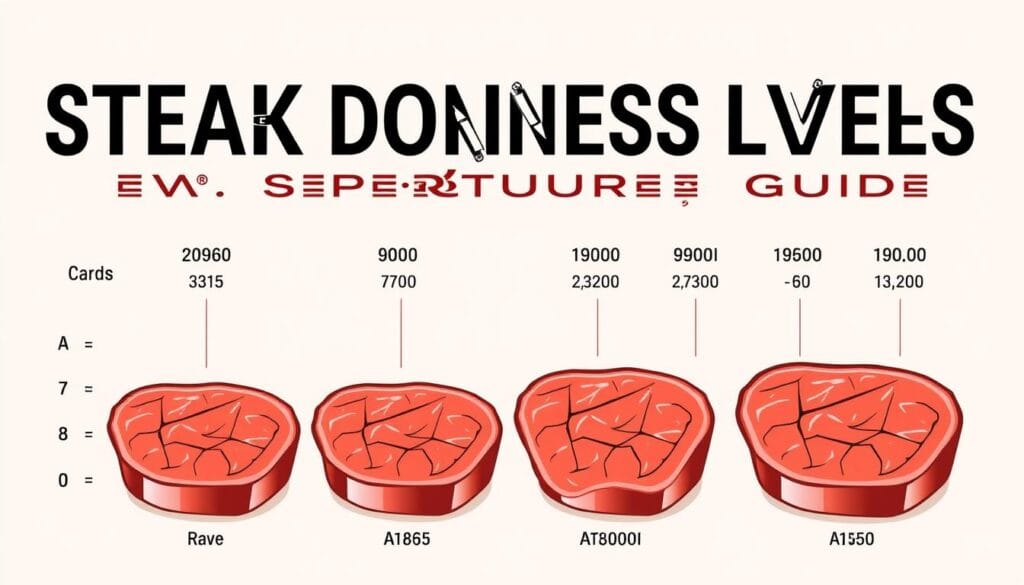
Mastering steak doneness levels is key to making the perfect Denver steak. The internal temperature affects the meat’s texture, flavor, and juiciness. Both professional chefs and home cooks use precise temperatures to get their desired results.
An instant-read thermometer is the best tool for tracking steak doneness levels accurately. Here are the key temperature ranges for different levels of doneness:
- Rare: 125°F (very red center)
- Medium-Rare: 135°F (warm red center)
- Medium: 145°F (pink center)
- Medium-Well: 150°F (slight pink center)
- Well-Done: 160°F (no pink)
When checking steak doneness levels, remember that the meat continues cooking after removal from heat. This process, called carryover cooking, means you should remove the steak from the heat source about 5 degrees below your target temperature. For a Denver steak, medium-rare (135°F) is often recommended to preserve the cut’s natural tenderness and rich flavor.
Pro tip: Let your steak rest for 5-10 minutes after cooking to allow juices to redistribute, ensuring a more flavorful and tender eating experience.
Each doneness level offers a unique eating experience. Your personal preference matters most, but understanding these temperature guidelines will help you cook the perfect Denver steak every time.
Best Cooking Methods and Techniques
Learning how to cook a Denver steak can make it go from good to amazing. Each method brings out different flavors and textures. This lets you tailor your meal to your liking. Knowing these techniques will help you make a meal as good as a restaurant’s, right in your kitchen.
Every cooking method has its own benefits for your Denver steak. The trick is to pick the right one based on your tools, skill, and taste preferences.
Pan-Searing Method
Pan-searing is a timeless way to cook steak that always impresses. Here’s how to do it right:
- Choose a heavy-bottomed cast-iron skillet
- Heat the pan until it’s very hot
- Add a bit of oil that can handle high heat
- Sear each side for 3-4 minutes
- Flip the steak with tongs
Grilling Instructions
Grilling adds a smoky taste to your Denver steak. Set up your grill for both direct and indirect heat. This lets you control the temperature perfectly.
| Grill Type | Temperature Range | Cooking Time |
|---|---|---|
| Gas Grill | 400-450°F | 4-5 minutes per side |
| Charcoal Grill | 450-500°F | 3-4 minutes per side |
Cold Pan Technique
The cold pan technique is a new way to cook steak. Start with a cold pan and heat it up slowly. This method helps cook the steak evenly and gives it a great crust.
Pro tip: Be patient with the cold pan technique. Slow heating prevents burning and ensures even cooking.
Creating Complementary Sauces and Seasonings
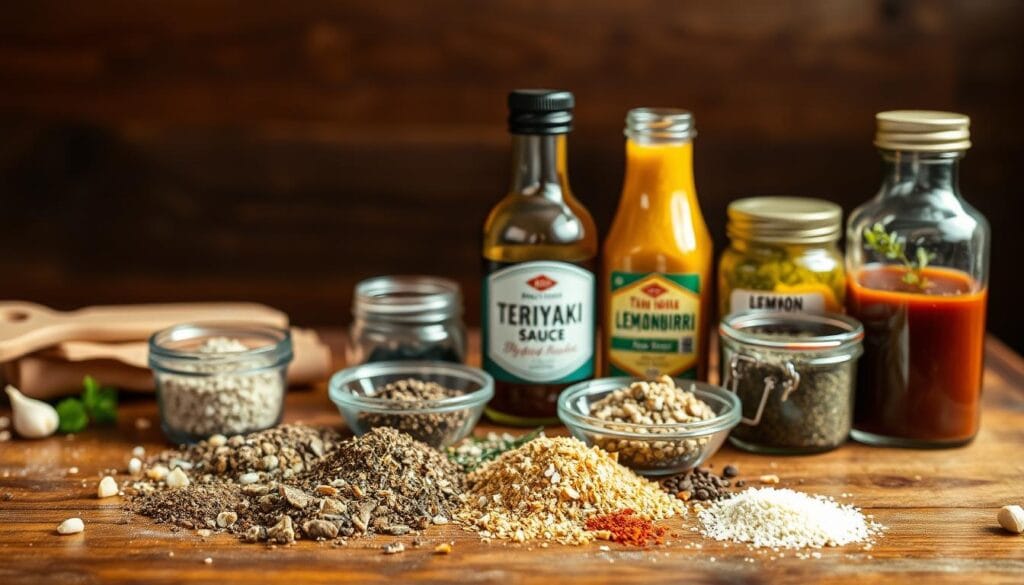
To take your Denver steak to the next level, use the right seasoning and marinades. The perfect sauce can turn your meat into a dish that wows your taste buds.
When making marinades for your Denver steak, aim for flavors that match the meat’s richness. Use seasoning blends that boost the steak’s taste without overpowering it.
- Chimichurri Sauce: A zesty Argentine-inspired blend of parsley, garlic, olive oil, and vinegar
- Garlic Butter Sauce: Rich, creamy, and packed with robust flavor
- Pan Drippings Sauce: Utilizing the steak’s own concentrated juices
Your denver steak seasoning can include a mix of ingredients like:
- Kosher salt
- Freshly ground black pepper
- Smoked paprika
- Dried herbs like thyme or rosemary
- Granulated garlic
For those wanting to experiment, try creating a custom dry rub by blending these spices. The key is finding a balance that highlights the Denver steak’s exceptional marbling and tenderness.
Pro tip: Always apply seasonings at least 30 minutes before cooking to allow flavors to penetrate the meat.
Perfect Side Dish Pairings
Enhancing your Denver steakhouse visit is more than just the meat. The right side dishes can make your meal unforgettable. It’s all about matching flavors, textures, and balance.
Vegetable Companions
Fresh veggies add a lively contrast to the Denver steak. Here are some tasty choices:
- Roasted asparagus with garlic
- Grilled Brussels sprouts with balsamic glaze
- Honey-glazed rainbow carrots
- Sautéed green beans with almonds
Starch Selections
Starches add depth to your meal with their textures and tastes:
- Creamy parmesan mashed potatoes
- Crispy rosemary roasted potato wedges
- Truffle mac and cheese
- Wild rice pilaf
Wine Pairing Suggestions
Choosing the right wine can enhance your meal. Red wines are best with Denver steak. Here are some top picks:
- Cabernet Sauvignon
- Malbec
- Syrah/Shiraz
Try these pairings to find your favorite. Create a meal that highlights the Denver steak’s rich flavor.
Storage and Leftover Tips
Keeping your denver steak recipe fresh is all about the right storage. After you’ve enjoyed your meal, you’ll want to keep the meat’s quality and taste.
Refrigeration is crucial for keeping your denver steak fresh. Store leftover steak in an airtight container to stop moisture loss and prevent bacteria. It’s best to keep it in the fridge for 3 to 4 days.
- Cool the steak completely before storing
- Use sealed glass or plastic containers
- Place in the coldest part of the refrigerator
Freezing is great for longer storage. Wrap your denver steak in freezer-safe packaging to avoid freezer burn. Frozen steak stays good for 2 to 3 months.
| Storage Method | Duration | Best Practices |
|---|---|---|
| Refrigeration | 3-4 days | Airtight container, lowest shelf |
| Freezing | 2-3 months | Vacuum seal or wrapped tightly |
Turn leftover denver steak into new dishes like salads, sandwiches, or stir-fries. Slice it thinly when cold and reheat it gently. This keeps it tender and prevents it from getting tough.
Pro tip: Always reheat leftover steak at a low temperature to preserve its original juicy texture.
Conclusion
Cooking Denver steak is easy and fun. It’s a great choice for making tasty meals at home. With some practice, you can make this beef cut into a special dish.
The Denver steak recipe we shared is simple. It teaches you how to make a tender and flavorful meal. You’ll learn about the cut and how to sear it perfectly. Remember, patience and the right temperature are crucial for success.
Try different seasonings and cooking methods to make your Denver steak unique. You can pan-sear, grill, or use the cold pan technique. Each way brings out different flavors in this amazing beef.
Don’t be afraid to share your Denver steak recipes and stories. Your kitchen is ready to create amazing meals. Impress your loved ones with your culinary skills.

